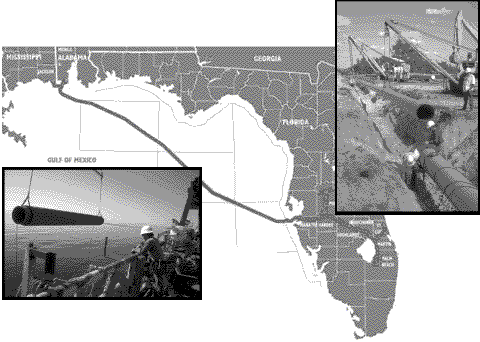
|
 |
Building Florida's First Offshore PipelineA new natural gas line stretching from South Alabama across the Gulf of Mexico, through Tampa Bay and over to Polk County is a technological wonder. Florida's first offshore pipeline, it can transport about 1.1 billion cubic feet of clean-burning natural gas every day - enough to create electricity for 4.5 million homes. More than 580 miles long - including 431 miles underwater - it took 2,500 workers almost a year to install 450,000 tons of pipe.
The underwater segments were assembled on a 1,000-foot- barge that covered about three or four miles per day. Pipe sections, each 40-feet-long and weighing 15 tons, were delivered to the barge twice daily. The concrete-coated sections were welded together, then tested with xray and ultrasound to ensure there were no leaks before they were lowered to the sea floor as much as 800 feet below the barge. Before the barge moved across Tampa Bay, divers physically relocated all soft and hard coral formations weighing less than 20 pounds from the path of the pipeline. On the surface, two spotters watched for wildlife, especially manatees and turtles. Work was halted on multiple occasions to ensure that these endangered species weren't troubled. Additionally, more than $500,000 was spent on a monitoring initiative that tested water quality before and after the barge moved through, although a zero discharge policy meant that nothing went overboard, even excess rainfall. To mitigate for damage caused by the pipeline, more than 111,250 separate structures will be deployed across 57.4 acres of underwater habitat, including 110,000 limestone boulders and 250 reef modules. The boulders are three feet in diameter and each weigh about a ton. The deep-water reef modules are made of limestone in a concrete matrix with an internal cavity and very rough surface. They were placed in areas that the Florida Department of Environmental Protection, the Florida Marine Research Institute and the National Marine Fisheries Service determined would have the greatest positive impact. The modules provide some ecological benefits that can't be duplicated by the boulders. However, the natural boulders most closely resemble the hard bottom already on the sea floor.
|

 In Tampa Bay, about 150 soft corals were carefully transplanted to reef modules specially designed for waters as shallow as 18 feet. Placed within 1000 to 2000 feet of the pipeline, scientists are hopeful that the reefs will attract wildlife ranging from tiny crabs and sponges to grouper and other large fish. The limestone in the modules comes from an ancient reef site - now a limestone quarry - north of Tampa and the modules were designed to mimic the hard bottom found in Tampa Bay.
In Tampa Bay, about 150 soft corals were carefully transplanted to reef modules specially designed for waters as shallow as 18 feet. Placed within 1000 to 2000 feet of the pipeline, scientists are hopeful that the reefs will attract wildlife ranging from tiny crabs and sponges to grouper and other large fish. The limestone in the modules comes from an ancient reef site - now a limestone quarry - north of Tampa and the modules were designed to mimic the hard bottom found in Tampa Bay.